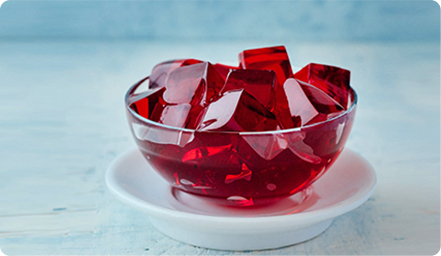-
July, 26,2025
Understanding the Role of Bloom Strength in Soft Gelatin Capsules
-
July, 25,2025
Bloom Strength and Its Impact on Hard Gelatin Capsules
-
July, 21,2025
How Gelatin Is Revolutionizing Pet Food: A Healthier Option for Dogs
-
June, 22,2025
Collagen as a Trusted Ingredient: Meeting Global Demand with Reliable Supply
What is the History of Gelatin Desserts?
As a leading gelatin manufacturer, we deeply appreciate the fascinating journey gelatin has traveled — from ancient culinary traditions to the dazzling, colorful desserts we know today. Understanding the history of gelatin desserts not only highlights gelatin’s culinary versatility but also emphasizes the importance of high-quality gelatin in modern food innovation.
In this article, we explore the history of gelatin, the evolution of gelatin desserts, and why selecting a trusted gelatin supplier is critical for today’s food industry.
Ancient Origins of Gelatin
Early Use in Ancient Egypt and Rome
Gelatin’s history dates back thousands of years. Ancient Egyptians and Romans discovered that slow-boiling animal bones and connective tissues produced a rich, gel-like substance. Although this early gelatin was primarily used for savory purposes, such as preserving meats or creating aspics, it demonstrated gelatin’s unique ability to create structure and stability in foods.
This painstaking process required hours, sometimes days, of preparation, making gelatin-based foods a rare luxury. Unlike today’s streamlined gelatin production methods, ancient gelatin was a labor-intensive product reserved mainly for religious ceremonies and elite banquets.
From the beginning, gelatin’s unique functional properties — setting, thickening, and stabilizing — were recognized, setting the foundation for its later evolution into sweet confections.
Medieval Symbol of Wealth and Status
By the Middle Ages, gelatin had become a symbol of wealth and prestige. Extraction methods were still highly time-consuming, often requiring dedicated kitchen staff to simmer animal parts to produce even small quantities of gelatin.
At royal feasts and noble gatherings, elaborately molded gelatin dishes were often showcased as a testament to a host’s status and resources. These intricate aspics, filled with meats, fruits, or vegetables, not only delighted the palate but also demonstrated the technological prowess and culinary artistry of the time.
The association between gelatin and luxury created a lasting impression that would later influence its position in dessert culture, transforming it from a savory delicacy into a sweet, accessible treat with the advancement of food technology.
From Savory to Sweet: The Evolution of Gelatin Desserts
Early Aspics and Decorative Dishes
During the Renaissance and early modern period in Europe, gelatin continued to feature prominently in savory dishes known as aspics. These cold, jelly-like dishes encased meats, vegetables, or seafood in a clear gelatin layer, preserving the food and enhancing its visual appeal.
Cookbooks from the 15th to 17th centuries, such as Le Viandier by Taillevent (France) and The English Huswife by Gervase Markham (England), include recipes that required intricate gelatin preparation. Gelatin’s ability to stabilize complex decorative displays made it popular for court banquets and special occasions.
At this stage, gelatin was still an expensive, labor-intensive product reserved for the upper class. Its culinary role remained largely savory, reinforcing its association with prestige and opulence.
Introduction of Sweetened Gelatin
The transformation of gelatin from a savory medium to a sweet dessert base began in the 18th and early 19th centuries. Sugar, once an expensive commodity itself, became increasingly affordable with the expansion of global sugar trade. This made sweet confections more accessible to a broader segment of society.
Innovative cooks began combining clarified gelatin with sweetened fruit juices, wines, or creams, creating the earliest versions of fruit-flavored gelatin desserts. These desserts were served chilled and often molded into elaborate shapes, maintaining gelatin’s visual appeal while offering a lighter, refreshing taste experience.
By the late 18th century, recipes for "transparent jellies" or "fruit jellies" appeared in English and American cookbooks, laying the groundwork for the gelatin-based desserts we recognize today.
Industrialization and the Rise of Commercial Gelatin
|
|
|
|
|
|
|
|
|
|
|
|
|
|
|
|
|
|
|
|
Peter Cooper’s Instant Gelatin Patent
A major turning point in the history of gelatin desserts came in 1845 when American inventor Peter Cooper patented a method for making a powdered gelatin. (U.S. Patent No. 4084, issued February 15, 1845.)
Cooper’s invention simplified the previously time-consuming gelatin extraction process. His product was a gelatin powder that could be easily dissolved in hot water, making it far more convenient for both commercial and household use.
However, despite the innovation, Cooper did not actively market or commercialize his gelatin product as a dessert. It would take several decades — and the creativity of new entrepreneurs — to fully unlock its potential in the food industry.
Knox and the Home Cooking Revolution
In the late 19th century, Charles B. Knox of Johnstown, New York, played a critical role in popularizing gelatin for everyday use.
After observing his wife manually making gelatin at home (by boiling calves' feet), Knox realized the need for a more accessible, ready-to-use product.
In 1890, he founded the Knox Gelatin Company, producing sheet and powdered gelatin intended for household cooks.
Knox emphasized the importance of purity, consistency, and ease of preparation, marketing gelatin as a product that could create reliable results in a home kitchen.
Knox’s marketing efforts were revolutionary:
- He published recipe booklets featuring gelatin desserts, salads, and aspics.
- His promotions emphasized the health benefits of gelatin, including digestion and bone health — a trend that resonates even today.
Through Knox’s efforts, gelatin was no longer confined to wealthy households or professional kitchens. It became a mainstay in middle-class American cooking, especially for desserts and molded salads.
Today, trusted partners like Funingpu gelatin continue this legacy, offering high-purity gelatin powder wholesale options that meet the diverse needs of modern dessert manufacturers.
Jell-O and the 20th-Century Dessert Boom
In 1897, Pearle Bixby Wait, a carpenter and cough syrup manufacturer in LeRoy, New York, developed a fruit-flavored gelatin dessert, combining Cooper’s powdered gelatin base with sweeteners and flavorings. His wife, May Wait, coined the name "Jell-O."
Unfortunately, the Waits were not successful marketers and sold the rights to Jell-O for $450 to Orator Frank Woodward in 1899.
Woodward’s Genesee Pure Food Company aggressively marketed Jell-O with colorful advertisements, free sample promotions, and recipe booklets — tactics that rapidly boosted the brand's popularity.
By the early 20th century:
- Jell-O had become a household name.
- It symbolized modernity, convenience, and creativity in home cooking.
- Jell-O desserts, particularly molded salads and fruit-laden gelatin creations, became a hallmark of American culinary life, especially between the 1920s and 1960s.
Gelatin Desserts and Cultural Significance
Post-War America: Convenience and Creativity
Following World War II, gelatin desserts solidified their place in American kitchens. In the 1950s and 1960s, as domestic life emphasized convenience, appearance, and hospitality, gelatin products like Jell-O became symbols of modern homemaking.
Key factors that drove gelatin desserts' popularity during this era:
- Refrigerators became common household appliances, making it easier to chill and mold gelatin dishes.
- Mass production and affordable pricing made flavored gelatin accessible to nearly every American household.
- Marketing campaigns positioned gelatin salads and desserts as elegant, easy-to-prepare dishes suitable for potlucks, picnics, and dinner parties.
The creativity of home cooks flourished. Elaborate gelatin molds filled with fruits, vegetables, marshmallows, whipped toppings, and even seafood appeared in mid-century cookbooks. These colorful, sculptural dishes reflected the era's fascination with visual presentation and culinary innovation.
Global Adaptations of Gelatin-Based Desserts
While gelatin desserts became iconic in America, their versatility allowed them to thrive around the world in various local adaptations:
- Japan:
- Introduced Coffee Jelly in the early 20th century, often served in cafés as a trendy, slightly bitter dessert.
- Coffee jelly typically uses gelatin to set sweetened black coffee into a soft, spoonable gel.
- Philippines:
- Developed desserts like Gulaman, made with either gelatin or agar.
- Popular dishes such as buko pandan salad (young coconut with gelatin cubes and cream) highlight gelatin’s role in tropical climates.
- United King:
- Incorporated gelatin into classic desserts like trifle, a layered dish of sponge cake, custard, fruit, and gelatin.
- Incorporated gelatin into classic desserts like trifle, a layered dish of sponge cake, custard, fruit, and gelatin.
- Latin America:
- Embraced colorful, multi-layered gelatin desserts (known as "gelatina de mosaico") that showcase artistic designs and vibrant colors.
- Embraced colorful, multi-layered gelatin desserts (known as "gelatina de mosaico") that showcase artistic designs and vibrant colors.
These global interpretations demonstrate gelatin’s incredible adaptability across flavors, cultural preferences, and culinary styles.
Modern Trends and Innovations in Gelatin Desserts
Health-Conscious and Functional Gelatin Applications
As consumer preferences shift towards health-conscious eating, gelatin desserts have also evolved. Modern trends emphasize not only indulgence but also nutritional value and clean-label ingredients.
Several important developments include:
- Reduced Sugar Formulations:
- Many gelatin dessert brands now offer sugar-free or reduced-sugar options to meet the demand for lower-calorie products.
- Many gelatin dessert brands now offer sugar-free or reduced-sugar options to meet the demand for lower-calorie products.
- Enriched Gelatin Desserts:
- Some products incorporate added collagen peptides, promoting benefits for skin health, joint support, and digestive wellness.
- Clinical research supports the role of collagen supplementation in improving skin elasticity and joint function, making functional gelatin desserts a growing niche.
- Clean-Label and Natural Colors/Flavors:
- Consumers increasingly seek gelatin desserts made with natural fruit extracts, plant-based colorants, and fewer artificial additives.
- Consumers increasingly seek gelatin desserts made with natural fruit extracts, plant-based colorants, and fewer artificial additives.
This shift highlights an important role for high-quality gelatin manufacturing — ensuring consistency, purity, and compatibility with clean-label formulations.
As a specialized gelatin manufacturer, Funingpu provides solutions that support these health-forward trends — including collagen-enriched formulations and clean-label dessert gelatin options tailored to specific customer needs.
Rise of Plant-Based Alternatives
In response to the growth of vegan and vegetarian diets, plant-based gelling agents have gained popularity as alternatives to traditional gelatin.
Common substitutes include:
- Agar-Agar:
- Extracted from red algae; commonly used in Asian cuisines.
- Forms a firmer gel and is heat-stable but lacks gelatin’s elastic texture.
- Pectin:
- Found naturally in fruits like apples and citrus.
- Used primarily in jams, jellies, and some dessert applications.
- Carrageenan:
- Also derived from red seaweed, often used in dairy and non-dairy desserts.
- Also derived from red seaweed, often used in dairy and non-dairy desserts.
While these alternatives offer solutions for plant-based consumers, traditional animal-derived gelatin remains irreplaceable for certain applications requiring:
- A smooth, elastic mouthfeel (unique to gelatin),
- Stable foams in mousses and marshmallows,
- Clear, glossy finishes in layered desserts.
Thus, gelatin continues to play an essential role in premium dessert formulations across the world.
|
|
|
|
|
|
|
|
|
|
|
|
|
|
|
|
|
|
|
|
|
|
|
|
|
|
|
|
|
|
|
|
|
|
|
|
Why High-Quality Gelatin Matters for Today's Desserts
Consistency, Texture, and Taste
In today’s competitive food landscape, product consistency is critical. Whether developing a simple fruit gelatin cup or an elaborate multi-layered dessert, manufacturers and chefs require gelatin that:
- Delivers predictable gelling strength (typically measured by BLOOM value),
- Provides uniform texture across batches,
- Enhances taste experience without unwanted odors or aftertastes.
Low-quality gelatin can lead to inconsistent setting, cloudiness, poor mouthfeel, and product failures — challenges that no commercial kitchen or factory can afford.
Supporting Innovation and New Product Development
Modern food R&D teams increasingly seek gelatin suppliers who offer:
- Customizable gelatin specifications (adjustable BLOOM strength, viscosity, particle size),
- Halal, Kosher, and clean-label options to meet global certification standards,
- Support for functional food trends (collagen-enriched desserts, digestive health products),
- Technical support and innovation collaboration during new product development.
A trusted gelatin manufacturer does not just deliver an ingredient — they become a partner in innovation, helping clients bring new dessert concepts to market faster and more successfully.
Our Commitment to Excellence in Gelatin Manufacturing
At Funingpu, we are dedicated to producing high-purity, high-performance gelatin solutions that support the evolving needs of the global food industry.
With rigorous quality control, advanced processing technologies, and deep expertise in gelatin functionality, we empower our partners to:
- Create visually stunning, delicious desserts,
- Maintain product integrity and customer satisfaction,
- Meet diverse regulatory, dietary, and certification requirements.
As the history of gelatin desserts continues to evolve, we stand ready to help you craft the next generation of memorable creations.
Final Thoughts
The journey of gelatin desserts — from ancient savory aspics to today’s innovative, health-conscious creations — reflects centuries of culinary evolution, technological advancement, and changing consumer preferences.
Throughout history, one constant has remained: the critical role of high-quality gelatin in achieving the perfect texture, clarity, and stability.
As new trends continue to shape the dessert industry, selecting a trusted gelatin manufacturer like Funingpu gelatin becomes even more essential. Whether crafting classic favorites or pioneering modern functional foods, partnering with an expert supplier ensures consistency, creativity, and excellence in every product.
Phone: +86-577-88105990
Mobile: +86-138 5886 1938
Official Website: www.fnp-gelatin.com
Email: sales@funingpu.com
Address: No. 1-10 Wenpu Road, Yacheng Town, Xiapu County, Ningde City, Fujian Province




